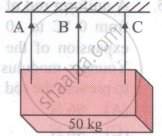Advertisements
Advertisements
प्रश्न
Four identical hollow cylindrical columns of mild steel support a big structure of mass 50,000 kg. The inner and outer radii of each column are 30 cm and 60 cm respectively. Assuming the load distribution to be uniform, calculate the compressional strain of each column.
उत्तर १
Mass of the big structure, M = 50,000 kg
Inner radius of the column, r = 30 cm = 0.3 m
Outer radius of the column, R = 60 cm = 0.6 m
Young’s modulus of steel, Y = 2 × 1011 Pa
Total force exerted, F = Mg = 50000 × 9.8 N
Stress = Force exerted on a single column = `(50000 xx 9.8)/4 = 122500 N`
Young’s modulus, Y = Stress/Strain
Strain = `(F/A)/Y`
Where
Area, `A =pi(R^2 - r^2) = pi((0.6)^2 - (0.3)^2)`
`"Strain" = 122500/(pi[(0.6)^2 - (0.3)^2]xx2xx10^11) = 7.22 xx10^(-7)`
Hence, the compressional strain of each column is 7.22 × 10–7.
उत्तर २
Here total mass to be supported, M = 50,000 kg
∴ Total weight of the structure to be supported = Mg
= 50000 x 9.8 N
Since the weight is to be supported by 4 columns
∴Compressional force on each column (F) is given by
`F = "Mg"/4 = (50000xx9.8)/4 N`
Inner radius of columns, `r_1 = 30 cm = 0.3 m`
Outer radius of column, r_2 = 60 cm = 0.6 m
∴ Area of cross- section of each column is given by
`A = pi(r_2^2 - r_1^2)`
`=pi[(0.6)^2 - (0.3)^2] = 0.27 pi m^2`
Young's Modulus, `Y = 2 xx 10^11` Pa
Compressional strain of each column = ?
∴`Y = "Compressional force/area"/"Compressional Strain"`
`= "F/A"/"Compressional Strain"`
or Compressional strain of each column
`= F/(AY)= (50000xx9.8xx7)/(4xx0.27xx22xx2xx10^11)`
`= 0.722 xx 10^(6)`
∴ Compressional strain of all columns is given by
`= 0.722 xx 10^(-6) xx 4 = 2.88 xx 10^(-6)`
`= 2.88 xx 10^(-6)`
APPEARS IN
संबंधित प्रश्न
A steel wire of length 4.7 m and cross-sectional area 3.0 × 10–5 m2 stretches by the same amount as a copper wire of length 3.5 m and cross-sectional area of 4.0 × 10–5 m2 under a given load. What is the ratio of Young’s modulus of steel to that of copper?
Two wires A and B are made of same material. The wire A has a length l and diameter rwhile the wire B has a length 2l and diameter r/2. If the two wires are stretched by the same force, the elongation in A divided by the elongation in B is
A wire elongates by 1.0 mm when a load W is hung from it. If this wire goes over a a pulley and two weights W each are hung at the two ends, he elongation of he wire will be
The length of a metal wire is l1 when the tension in it T1 and is l2 when the tension is T2. The natural length of the wire is
A steel rod of cross-sectional area 4 cm2 and 2 m shrinks by 0.1 cm as the temperature decreases in night. If the rod is clamped at both ends during the day hours, find the tension developed in it during night hours. Young modulus of steel = 1.9 × 1011 N m−2.
A uniform rectangular block of mass of 50 kg is hung horizontally with the help of three wires A, B and C each of length and area of 2m and 10mm2 respectively as shown in the figure. The central wire is passing through the centre of gravity and is made of material of Young's modulus 7.5 x 1010 Nm−2 and the other two wires A and C symmetrically placed on either side of the wire B are of Young's modulus 1011 Nm−2 The tension in the wires A and B will be in the ratio of:

The temperature of a wire is doubled. The Young’s modulus of elasticity ______.
In nature, the failure of structural members usually result from large torque because of twisting or bending rather than due to tensile or compressive strains. This process of structural breakdown is called buckling and in cases of tall cylindrical structures like trees, the torque is caused by its own weight bending the structure. Thus the vertical through the centre of gravity does not fall within the base. The elastic torque caused because of this bending about the central axis of the tree is given by `(Ypir^4)/(4R) . Y` is the Young’s modulus, r is the radius of the trunk and R is the radius of curvature of the bent surface along the height of the tree containing the centre of gravity (the neutral surface). Estimate the critical height of a tree for a given radius of the trunk.
In nature, the failure of structural members usually result from large torque because of twisting or bending rather than due to tensile or compressive strains. This process of structural breakdown is called buckling and in cases of tall cylindrical structures like trees, the torque is caused by its own weight bending the structure. Thus the vertical through the centre of gravity does not fall within the base. The elastic torque caused because of this bending about the central axis of the tree is given by `(Ypir^4)/(4R) . Y` is the Young’s modulus, r is the radius of the trunk and R is the radius of curvature of the bent surface along the height of the tree containing the centre of gravity (the neutral surface). Estimate the critical height of a tree for a given radius of the trunk.
The force required to stretch a wire of cross section 1 cm2 to double its length will be ______.
(Given Young's modulus of the wire = 2 × 1011 N/m2)
